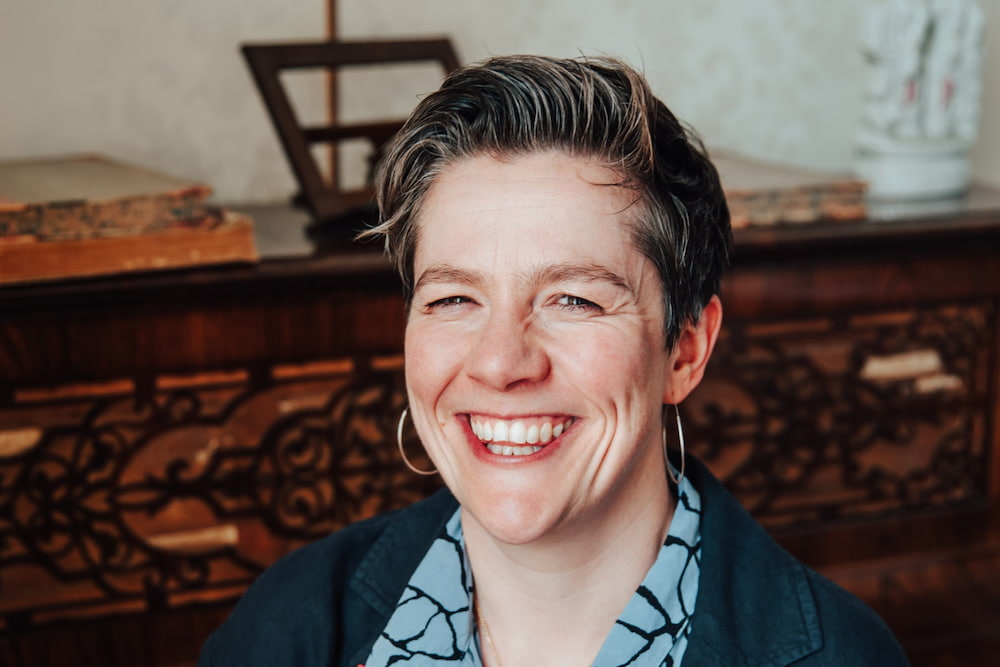Photo credit: Melissa Rodrigues / Jersey Heritage
25 November 2025
Annie Gray is a historian, author and broadcaster. She is the author of several books including The Greedy Queen, which explored the eating habits of Queen Victoria, and Victory in the Kitchen.
Annie’s latest book is The Bookshop, The Draper, The Candlestick Maker, a fascinating history of the high street which takes the reader from the medieval market places through to the concrete precincts we have today.
You can find Annie’s latest book and her other titles on the Suffolk Community Libraries catalogue.
What was your first introduction to books and reading? Were you surrounded by books as a child or did you visit a library?
My mother was a primary school teacher, so I learnt to read before I properly started school and always loved it. I grew up with lots of books around me (I used to nick my father’s books when he left them in the loo), and we went to the library every Saturday. This was the 1980s when you got pin badges for reading books and I think I had the lot.
When I was 15 the local library burnt down (in Norwich). I cried for about a week and then read my way through the mobile library stock because I was convinced they were the only books left in the county – I read some really weird books that year.
When did you start your interest in the history of food and what was your path to publication?
I did a history undergraduate degree and it left me a bit cold – very much political history and the great man school of things. Then I did a Masters in historical archaeology (archaeology post 1450ish) and as part of that we studied domestic rituals around chocolate, tea and coffee. I was hooked. I loved food anyway, and was a keen cook, having spent 3 years in France as a teen, and the two just clicked. Plus, by then I knew I wanted to work as a public historian, and food is a universal topic, so a great way in.
As for publication, I was approached by an agent shortly after the first episode of The Kitchen Cabinet aired (a radio 4 culinary panel show hosted by Jay Rayner). We worked together on a book proposal – it still took about 3 years, but eventually The Greedy Queen was born.
What is your writing routine and how do you choose a subject to research and write about?
Routine? Ha ha ha. Very few authors make enough purely from writing to just write, so my weeks are rarely routined. Plus, I am crap in the mornings, so I get up and go for a swim or something. By mid-morning I have run out of ways to procrastinate, so I stand at a desk and write stuff until I get hungry. I do my best work in the afternoon, armed with tea and panic. Slightly more seriously, I also have self-imposed goals to hit and a deadly work ethic.
What to write about comes from various sources. My three main books – The Greedy Queen (a culinary biography of Queen Victoria), Victory in the Kitchen (about Churchill’s longest serving cook, but secretly about domestic service in the twentieth century) and The Bookshop, The Draper, The Candlestick Maker (my latest, a history of the high street), were all my ideas after a lot of thought and reading and thinking about the stories I wanted to tell. My book on Christmas food (one of my favourites) was a suggestion from my publisher. I’ve also been commissioned to write some books, notably tie-in cookery books and a history of Bettys of Harrogate.
Can you tell us a little about your latest book, The Bookshop, The Draper, The Candlestick Maker, and how you came to write it?
It was a lockdown book, born partly out of blind rage. I got increasingly riled by the discourse around the high street dying, while staring at queues of people at supermarkets, and hearing about Amazon’s ludicrous profits. I knew that the high street barely existed 500 years ago, so I went off to find a book on it so I could shout at people in an informed manner, and then discovered nobody had written a decent history of the high street since 1966. So I wrote one. It was also a really good topic for me to stretch my writing chops – I wanted to make it as immersive and sensory as possible, and it was a great topic for that.
The story of the high street is in many ways the story of women and their changing role in society. Were you aware of this when you started writing or did it become apparent as you researched?
Pretty much everything I write is about forgotten or less visible people in society, which tends to mean women. I was very aware of the way in which women have been pivotal to the story of the high street – both as shoppers and shop assistants – and it was a key element I wanted to bring out. Inevitably, there’s a lot to reflect on for today’s society in the book, including the age-old tension between shoppers – particularly women – as having agency and the ability to make informed choices – versus being easily marketed to passive spenders.
There are some amazing facts in the book. What did you find out that most surprised you?
The little details are fascinating. I take the view that if it surprises or amused me, it probably will a reader. I got totally sucked into the ways in which shops got people through the doors with large scale stunts. Elephants! Gold coin filled cheeses! Giant hoovers! And the mummified hand on display at Lewis’s of Liverpool in the early twentieth century.
What’s next for you?
Back to hard core food history, with a couple of books lined up for publication in 2027. Watch this space etc. I’m also working with The Food Museum in Stowmarket on some videos for their social media feed: they have a fabulous team, and a really interesting set of stories to tell.
As a library service, we’re always looking for our next great read. One book you would recommend to everyone?
Alison Light’s Mrs Woolf and the Servants was a real influence on me. It’s brilliantly written and a really good example of social history.
Can you tell us one thing about yourself that your readers may not know?
I used to work as a ghost tour guide in York: it taught me a lot about crowd control and I got very good at dealing with hecklers…including a flasher. But that’s a whole other story.

